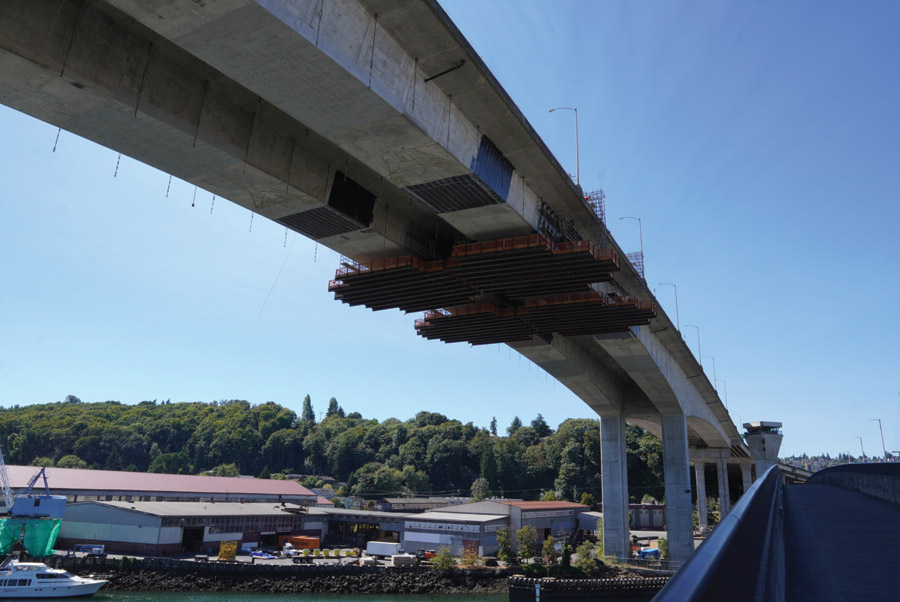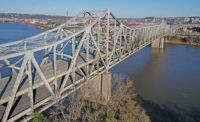2023 ENR Northwest Best Projects
Best Project, Highway/Bridge: The West Seattle Corridor Bridge Rehabilitation and Strengthening (WSCBRS) Project

Photo courtesy WSP
The West Seattle Corridor Bridge Rehabilitation and Strengthening (WSCBRS) Project
Seattle
Best Project
Submitted by: WSP USA
Owner: Seattle Dept. of Transportation
Lead Design Firm: WSP USA
General Contractor: Kraemer North America
Geotechnical: Shannon & Wilson
Surveying: 1-Alliance
Consultants/Subcontractors: Bridge Diagnostics Inc.; HDR; HNTB; Kelly McNut Consulting; Raedeke Associates Inc.; RS&H; Tinnea & Associates LLC; Structural Technologies
As one of three bridges that connect the West Seattle Peninsula to the rest of the city, the $64-million West Seattle High-Rise Bridge (WSHB) is a critical piece of infrastructure because the next available access point is more than four miles south of Seattle. More than 125,000 commuters rely on the bridge to cross the Duwamish River into downtown.
After a routine inspection discovered structural cracking in March 2020, the bridge was immediately closed and stabilized. To do this, the WSP team used large steel weldment post-tensioning anchors located in the middle of the bottom slab.
Dispersing heavy traffic to parts of the city with less capacity became the next goal, leading to the Reconnect West Seattle program. This effort promoted hundreds of projects, including 60 local street, signal, pedestrian and safety improvements in neighborhoods directly impacted by this abrupt closure.

Photo courtesy WSP
A structural health monitoring program along with stabilization measures helped prevent further cracking while the team determined rehabilitation measures. With measurements from the structural health instrumentation and more than 20 years of weather data from the University of Washington’s weather station, WSP was able to calibrate and predict the bridge’s behavior relative to actual measured data.
Because of the bridge detailing and the cracking and degradation that occurred, the bridge was relying on a non-codified shear resistance mechanism. Near-daily field inspections physically recorded crack growth until a 24/7 structural health monitoring system could be deployed and calibrated.
Along with stabilization efforts, a detailed cost-benefit analysis matrix helped the team assess the economic and technical feasibility of further rehabilitation, along with a series of workshops, meetings with a technical advisory panel and a community task force.

Photo courtesy WSP
Non-destructive testing ensured there was no high chloride content in the cement or grout and that no post-tensioning strands were severely corroded. Since all of the findings were favorable, WSP helped the city develop a contractor solicitation after completing a feasibility study.
The design solution needed to address the crack propagation, provide a durable solution and establish confidence in the bridge’s ability to ensure public safety. Adding tensioned cables to induce compression in the superstructure provides reinforcement and actively helps prevent cracking. A post-tensioning system was built inside of the hollow segmental box superstructure to avoid impacting the bridge aesthetic.
To add further strength, a carbon fiber wrapping was placed around the interior and exterior of the bridge and painted to match the existing concrete color.
Finally, sensors were installed inside the bridge to implement a 24/7 structural health monitoring system that will alert the Seattle Dept. of Transportation if the bridge exhibits behavior outside of the set safety parameters.
Rehabilitation took place under a GC/CM delivery. Standard construction methods incorporated more than three miles of epoxy crack injection, more than 40,000 sq ft of carbon fiber reinforced polymer sheets and 444 prestressing strands, stretching 52 miles. The $64-million rehabilitation project was delivered on time and under budget in September 2022.



